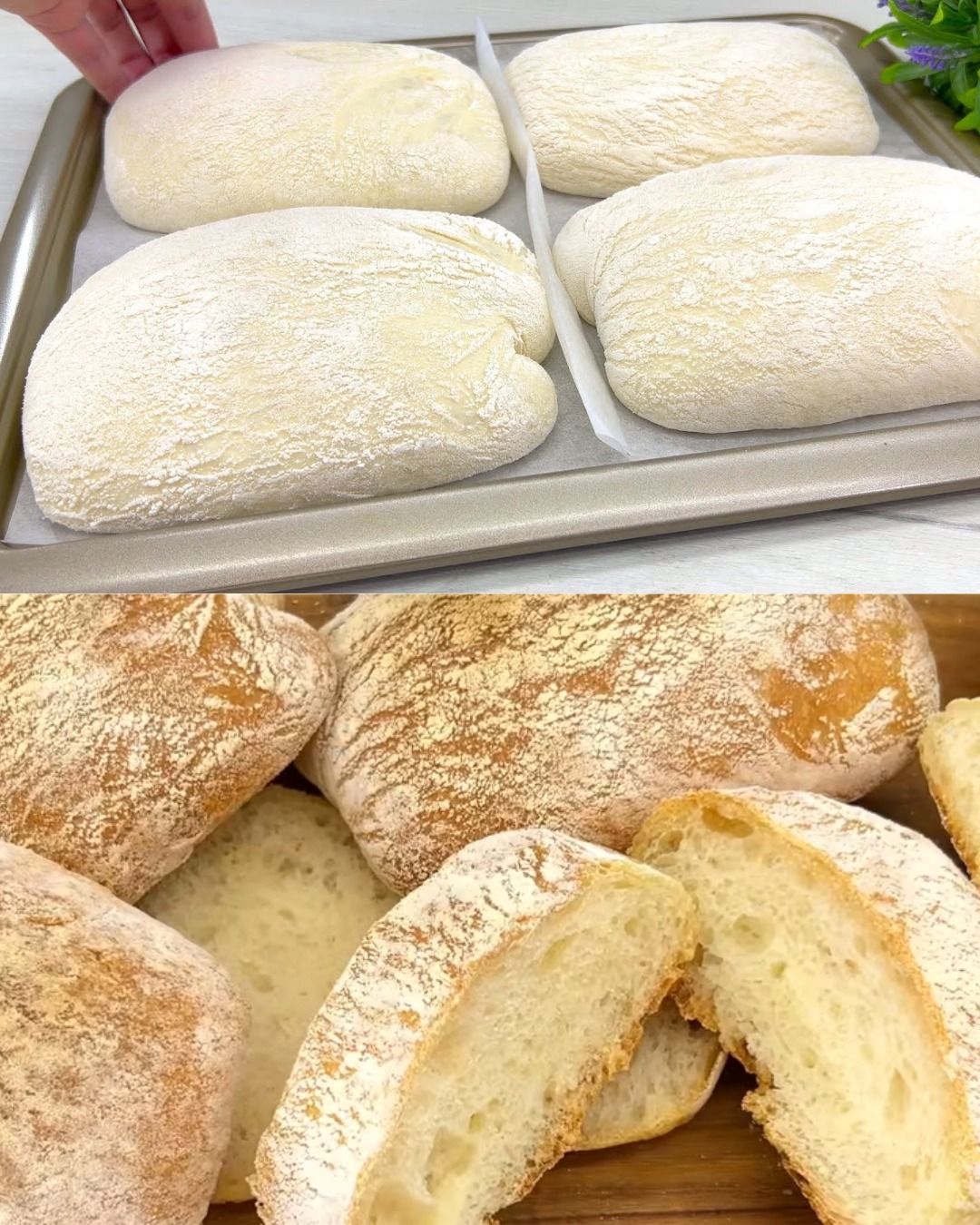Ever craved the delightful taste of authentic Italian ciabatta bread but thought it was too difficult to make at home? Think again! This recipe shows you how to create a beautifully airy, golden-crusted Italian bread with minimal effort and no kneading. Perfect for those who want to enjoy homemade bread without the hassle, this recipe is quick, easy, and delivers fantastic results in just over an hour. Whether you’re a seasoned baker or a beginner, you’ll love how simple this process is. Let’s get started!
Ingredients
For the Starter:
- Warm Water: 100 ml
- Purpose: Activates the yeast, providing the necessary environment for the fermentation process.
- Sugar: 1 teaspoon
- Purpose: Feeds the yeast, helping it to activate quickly.
- Dry Yeast: 8 g
- Purpose: The key ingredient for leavening, giving the bread its rise and airy texture.
- Wheat Flour: 3 tablespoons (full)
- Purpose: Provides structure to the starter, creating a smooth base for the dough.
For the Dough:
- Wheat Flour: 500 g (sifted)
- Purpose: The main component of the dough, providing the necessary gluten structure for the bread.
- Salt: 1.5 teaspoons
- Purpose: Enhances the flavor of the bread and strengthens the gluten network.
- Warm Water: 350 ml
- Purpose: Hydrates the flour, helping to form the dough and activate the yeast.
- Vegetable Oil: 30 ml
- Purpose: Adds moisture and helps achieve a soft crumb in the finished bread.
Instructions
1. Prepare the Starter:
- Combine Ingredients: In a small bowl, combine 100 ml of warm water, 1 teaspoon of sugar, 8 g of dry yeast, and 3 tablespoons of wheat flour.
- Tip: Ensure the water is warm (not hot) to activate the yeast without killing it.
- Mix: Stir the mixture well until it’s smooth and free of lumps.
- Cover and Let Rise: Cover the bowl with cling film and place it in a warm spot. Let the starter rise for about 15-20 minutes, or until it becomes bubbly and frothy.
- Tip: The rise time may vary depending on the temperature of your kitchen.
2. Prepare the Dough:
- Sift the Flour: In a large mixing bowl, sift 500 g of wheat flour to remove any lumps and ensure a light, airy texture in the finished bread.
- Tip: Sifting the flour also helps in evenly distributing the ingredients.
- Add Salt: Add 1.5 teaspoons of salt to the sifted flour and mix well to distribute evenly.
- Tip: Mixing the salt into the flour first ensures that it is evenly distributed and doesn’t come into direct contact with the yeast, which can inhibit its activity.
- Create an Indentation: Make a small well or indentation in the center of the flour mixture.
- Pour in Water: Pour 350 ml of warm water into the well.
- Tip: The warm water helps in dissolving the flour and activating the yeast further.
- Add the Starter: Add the risen starter to the flour mixture.
- Tip: The starter should be frothy and bubbly, indicating that the yeast is active.
- Mix the Dough: Using a wooden spoon or spatula, mix the ingredients together until a shaggy, sticky dough forms.
- Tip: The dough will be quite loose and sticky, which is exactly what you want for this type of bread.
- Incorporate the Oil: Add 30 ml of vegetable oil to the dough and mix thoroughly until the dough absorbs all the oil.
- Tip: The oil will make the dough more manageable and contribute to a tender crumb in the final product.
3. First Rise:
- Cover and Let Rise: Cover the bowl with cling film and place it in a warm spot. Let the dough rise for 15-20 minutes.
- Tip: The dough will start to puff up slightly during this time.
4. Turn the Dough:
- Fold the Dough: After the first rise, turn the dough over as shown in the video (or simply fold it over itself a few times in the bowl).
- Tip: Wet your hands slightly to prevent the dough from sticking too much.
- Cover and Let Rise Again: Cover with cling film and let the dough rise for another 15-20 minutes.
- Tip: This folding process helps to strengthen the dough’s structure, giving the bread a better rise.
5. Second Turn:
- Fold Again: Wet your hands with water to prevent sticking, and turn the dough over again, folding it as before.
- Tip: This step helps to build gluten and distribute the yeast evenly throughout the dough.
- Final Rise: Cover the bowl with cling film and let the dough rise for 50-60 minutes, or until it has doubled in size.
- Tip: The longer rise allows for more flavor development and a lighter, airier crumb.
6. Shape the Dough:
- Flour the Work Surface: Generously sprinkle your work surface with flour.
- Tip: This helps prevent the dough from sticking and makes it easier to shape.
- Turn Out the Dough: Carefully turn the dough out onto the floured surface. The dough will be quite liquid and sticky.
- Flatten and Fold: Gently flatten the dough and fold it several times to form a rough shape.
- Tip: Dust the dough and your hands with flour as needed to make handling easier.
- Divide the Dough: Dust the top of the dough generously with flour, then divide it into 4 equal parts using a bench scraper or knife.
- Tip: For an authentic look, shape the pieces into rustic, oval shapes reminiscent of ciabatta loaves.
- Prepare for Baking: Place the divided dough pieces onto a baking sheet lined with parchment paper.
- Tip: Leave enough space between the pieces to allow them to expand during baking.
7. Final Rise:
- Cover and Let Rise: Cover the dough pieces with a clean kitchen cloth and let them rise for another 30 minutes.
- Tip: This final rise will give the bread a light, airy texture and ensure a good oven spring.
8. Bake the Bread:
- Preheat the Oven: Preheat your oven to 200°C (392°F).
- Tip: A hot oven is key to getting a good crust on the bread.
- Create Steam: Place a bowl of boiling water in the oven to create steam. This helps in forming a nice, crusty exterior on the bread.
- Tip: Alternatively, you can spray the oven walls with water just before baking to create steam.
- Bake: Place the baking sheet in the preheated oven and bake the bread for 30-35 minutes, or until the tops are golden brown and crusty.
- Tip: The bread should sound hollow when tapped on the bottom, indicating it is fully baked.
9. Cool the Bread:
- Cool on a Rack: Once baked, remove the bread from the oven and transfer it to a wire rack to cool completely.
- Tip: Letting the bread cool on a rack prevents the bottom from becoming soggy and ensures a nice, crisp crust.
Conclusion
Congratulations! You’ve just made delicious, authentic Italian ciabatta bread with minimal effort and no kneading. The result is a light, airy loaf with a crispy crust, perfect for making sandwiches, dipping in olive oil, or enjoying with a bit of butter. This quick and easy recipe proves that you don’t need hours of labor to enjoy fresh, homemade bread.
Additional Notes:
- Storage: Store any leftover bread in an airtight container or bread bag to keep it fresh for a few days. If you prefer, you can also freeze the bread and reheat it in the oven when needed.
- Feedback: I’d love to hear how your bread turned out! Please leave your comments below and let me know if you made any variations to the recipe.
- Stay Connected: Don’t forget to subscribe and click the bell icon to get notified about new recipes. Happy baking, and enjoy your homemade Italian ciabatta bread!

